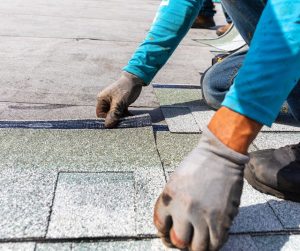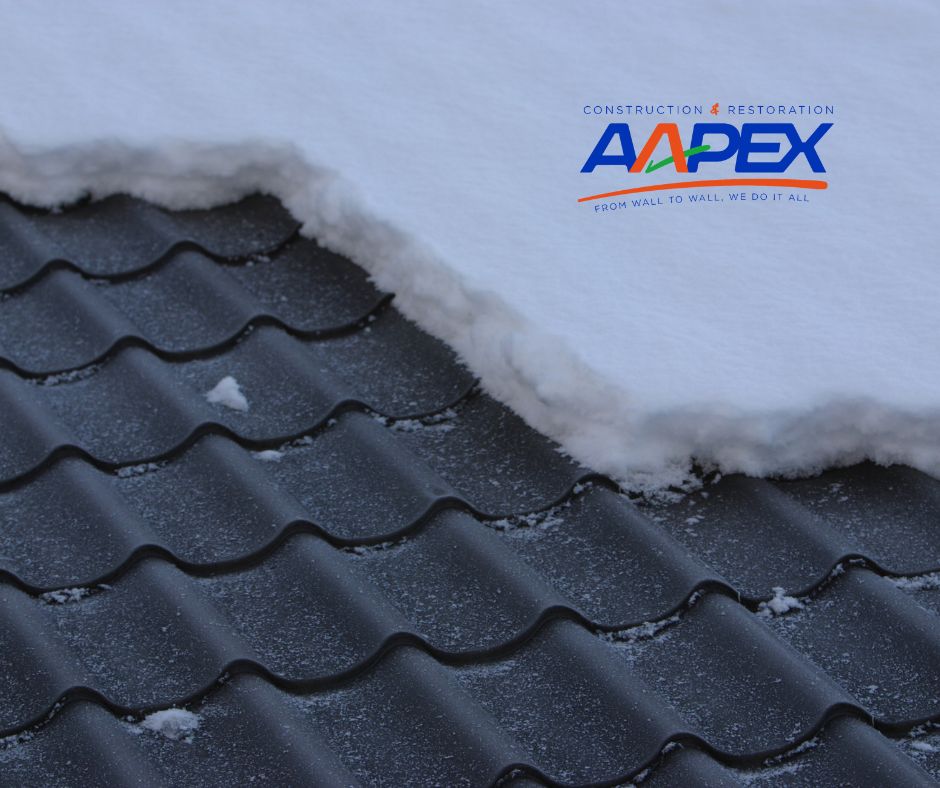Winter roofing projects can be a challenge. In our previous blog, we explained that the best time to clean your roof is on cloudy, calm, dry day. This is also the case with having new roofing installed. Roofing can occur in temps ranging from 40° to 90° F. Ideal outside temperatures should be between 70-80° F. This is when it’s the safest for both roofers and roofing materials. What happens if the temperature falls below that range? Can you still have the roofing installed?
Cold Weather Roof Installation Process
 During winter roofing, contractors have to ensure safety for themselves and the roof. They’re forced to take extra steps during winter work. Being on roofs in the winter can be a safety hazard in general for contractors. The weather makes them slippery, difficult to see, and difficult to walk on. Applying shingles in the winter is a more difficult process because of the extra work needed. The special adhesive is necessary for shingles. We’ve worked with GAF in the past. Here are things they state contactors would need to consider for winter roofing work:
During winter roofing, contractors have to ensure safety for themselves and the roof. They’re forced to take extra steps during winter work. Being on roofs in the winter can be a safety hazard in general for contractors. The weather makes them slippery, difficult to see, and difficult to walk on. Applying shingles in the winter is a more difficult process because of the extra work needed. The special adhesive is necessary for shingles. We’ve worked with GAF in the past. Here are things they state contactors would need to consider for winter roofing work:
- Store shingles in a heated area for 24 hours before use. This process makes the shingles more pliable and easier to install. The recommended temperature is above 70° F.
- It’s recommended to not use the racking method. Special care needs to occur during the winter months. Racking requires the lifting/bending of the shingles to place the last nail. This method may cause them to crack or break along the bend either immediately or in the future.
- Sealing time for the shingles will vary depending on many things. The slope of the roof, its orientation, and the amount heat exposure received all affect this. Hand sealing of shingles may necessary. If the temperature’s too cold, the adhesive won’t activate all the way.
The Dangers of Roof Installation in the Winter
 There are many different challenges and dangers of winter roofing. The first of these is the danger of being on the roof itself. Winter weather often brings snow and ice, which makes the roof more slippery. It can also be somewhat difficult to see, so extra safety is important to avoid slipping. Snow can also block or cover things like sky lights or damaged spots. Snow can also weigh enough to contribute to a collapsed roof. Danger of working on the roof can be even worse if a storm were to hit during the roofing process. Another danger of winter roofing is the problems it causes for tools. Contractors use several tools when roofing, like compressors and nail guns. Some of the steam and humidity in their lines will unavoidably turn into liquid and freeze when compression tools release air into them jeopardizing the tool’s performance.
There are many different challenges and dangers of winter roofing. The first of these is the danger of being on the roof itself. Winter weather often brings snow and ice, which makes the roof more slippery. It can also be somewhat difficult to see, so extra safety is important to avoid slipping. Snow can also block or cover things like sky lights or damaged spots. Snow can also weigh enough to contribute to a collapsed roof. Danger of working on the roof can be even worse if a storm were to hit during the roofing process. Another danger of winter roofing is the problems it causes for tools. Contractors use several tools when roofing, like compressors and nail guns. Some of the steam and humidity in their lines will unavoidably turn into liquid and freeze when compression tools release air into them jeopardizing the tool’s performance.
The shingles themselves pose as some of the biggest dangers in winter roofing. Winter installation often requires special adhesive for shingles. Cold weather prevents proper sealing and elasticity, which is why it’s needed. In temperatures below 40° F this adhesive goes on each shingle by hand. This leaves more room for error as normal adhesive is easier to work with. It’s also more reliable when it comes to sealing. Asphalt cannot bend in cold weather. Brittle shingles are more likely to sustain overdriven nails. This is because it’s more difficult to gauge the pressure needed for these nails in the cold. Applying shingles in cold weather also increases the chances of blow-offs.
Why You Should Wait
When it comes to why you should wait, there’s many reasons to take into consideration. As mentioned above, roofing materials contain an adhesive. A lot of these adhesives need the sun’s heat for activation. If it’s too cold outside and adhesive doesn’t work, you risk installation. If the temperature is below 40° F. you have a higher chance of a void warranty. Brittle shingles or poor adhesive can be detrimental to the lifespan of your roof. This can lead to earlier roof failure which will result in the need for replacement sooner. Another thing to consider is the fact that new roofing can take longer in the winter. Bad weather, available days, and holidays can all play a part in this. Finally, think about the physical aspect of your contractors. Contractors use their hands to install roofs, and thin gloves won’t do much for them in freezing temps. Due to these reasons, most roofing companies would say no to a job that would be better in warmer conditions.
The Advantage of Winter Roof Repairs
Instead of having your roof completely replaced, consider small repairs. Small repairs can prolong your roofs lifespan until it gets warm and safe outside again. Small winter roof repairs ensure you catch small problems before they progress. Harsh weather can create cracks or turn small cracks into larger ones. These cracks or leaks could let heat out of your home which could make living very uncomfortable. It would also cause your heat bill to skyrocket if heat is leaking. Small crack or leak repairs can prevent these things. Most roofing companies will tackle small repairs in the winter. These repairs are much simpler and safer than a full replacement in the cold weather.
To Conclude
If you’re worried about your roof, feel free to contact us. We’re willing to repair leaks or cracks to prevent further damage. We’re also here to give you a second opinion and ease your mind. We want to help your roof make it until warm weather for replacement. New roof installation can occur in the winter, but it leaves so much room for error. It also offers potential danger for both contractors and the integrity of your roof. It will save you money to wait until warmer weather for replacement. Faulty installation is common in the wintertime, even when done right. Nature can take an absolute tole on contactors, tools, and the materials themselves. The combo of a perfect temperature and the right weather is the key for success in roofing. Paired with professional roofers, your roof has the best chance at a long lifespan. Choose to repair small until it’s safe for replacement and choose us for your roofing needs.
Contact us today to learn more about your winter roofing options.
Additional Reading:


